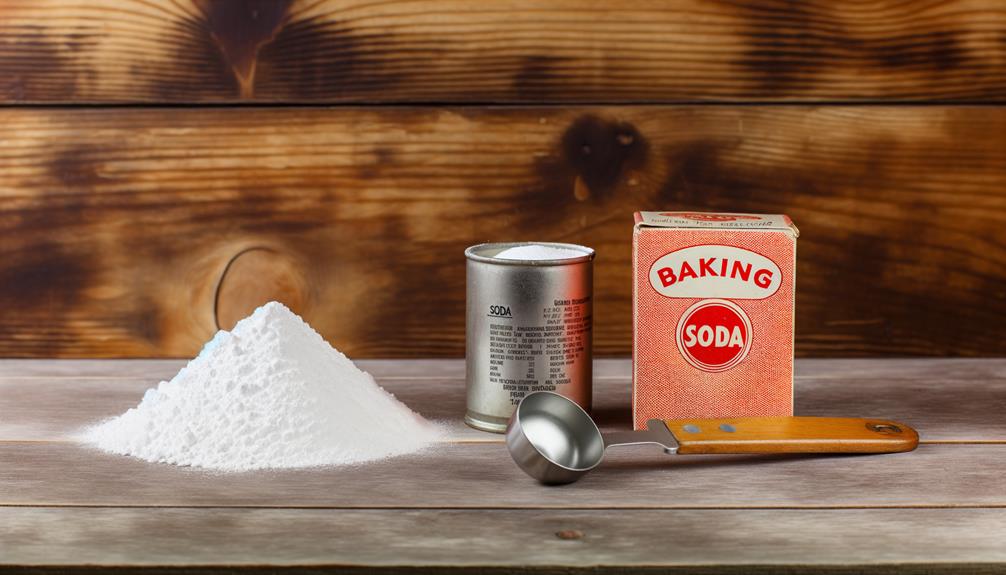Just as a gardener knows the importance of the soil’s pH to the vitality of their plants, you too should understand the pivotal role baking soda and baking powder play in your baking endeavors. Both are leavening agents, yet they’re not interchangeable – a concept that’s essential in traditional, plant-based baking. Baking soda requires an acidic counterpart to activate, reminiscent of ancient practices where natural ingredients were harnessed in harmony. On the other hand, baking powder is a ready-to-use mixture, simplifying modern baking without straying too far from its roots. You might find yourself wondering, how can you best utilize these components to elevate your baked goods? The nuances of their differences, the art of substitution, and the secret to always achieving the perfect rise are just ahead, beckoning you to explore further into the realm of authentic baking.
Key Takeaways
- Baking soda requires the presence of an acidic ingredient and a liquid to activate, while baking powder reacts with liquid and heat to activate.
- Baking soda is used with acidic ingredients like citrus juice, while baking powder is used when no acidic ingredient is present.
- Baking soda has stronger leavening power compared to baking powder, so three times as much baking powder is needed as a substitute for baking soda.
- When substituting baking soda for baking powder, an acidic component like cream of tartar should be added, and for every teaspoon of baking soda, three teaspoons of baking powder should be used as a substitute.
Understanding Baking Powder
Baking powder, a cornerstone of traditional baking, brings your recipes to life by releasing carbon dioxide when mixed and heated, ensuring your baked goods rise beautifully. This humble ingredient, composed of sodium bicarbonate, an acidic substance, and cornstarch, serves as a complete leavening agent. The cornstarch acts as a buffer, preventing premature reactions and contributing to the perfect texture of your cakes and cookies.
When you incorporate baking powder into your dough or batter, it reacts not once, but twice if it’s double-acting. The initial reaction occurs at room temperature, creating air bubbles that start the rising process. The second reaction takes place in the heat of your oven, further expanding these bubbles, and giving your baked creations their delightful fluffiness.
If your recipe doesn’t include an acidic component, baking powder effortlessly steps in, requiring no additional adjustments. However, if you’re substituting baking soda with baking powder, remember the ratio: you’ll need three times as much baking powder to achieve the same effect. This careful balance ensures that your efforts in the kitchen are fruitful, providing joy and nourishment to those you serve.
Exploring Baking Soda
After understanding the role of baking powder in your culinary creations, it’s crucial to explore baking soda, a similarly indispensable yet distinct ingredient in traditional baking. Unlike its counterpart, baking soda requires the presence of an acidic ingredient and a liquid to activate. This combination sparks a chemical reaction, producing carbon dioxide and causing your baked goods to rise, infusing them with lightness and texture that’s essential for that perfect bite.
When you’re diving into your plant-based recipes, remember that baking soda is your ally when working with natural acidic components like vinegar or lemon juice. Its strong leavening power, much greater than that of baking powder, means you’ll use less, making it a potent tool in your baking arsenal. Just a quarter teaspoon of baking soda is equivalent to a full teaspoon of baking powder.
However, wielding this power requires a mindful approach. Substituting baking soda for baking powder or vice versa isn’t straightforward due to their different compositions and activation requirements. Your dedication to crafting delightful, plant-based treats for others means paying close attention to these details, ensuring every baked good you serve is a testament to your care and skill.
Key Differences Highlighted
Understanding the key differences between baking soda and powder is essential as you embark on your journey to perfect plant-based baking. Both play pivotal roles in creating the light, airy textures we cherish in our baked goods, yet they come with their unique properties and applications. Embracing these distinctions not only honors the tradition of baking but empowers you to serve your loved ones with confidence.
| Aspect | Baking Soda | Baking Powder |
|---|---|---|
| Composition | Single ingredient: sodium bicarbonate | Contains sodium bicarbonate, an acidic ingredient, and cornstarch |
| Activation | Needs an acidic ingredient and liquid | Reacts with liquid and heat |
| Usage | With acidic ingredients (e.g., citrus juice) | When no acidic ingredient is present |
| Leavening Power | Stronger; more potent | Requires three times as much for same effect |
Mindful substitution is key, as the difference in activation and potency between baking soda and powder can significantly affect the outcome of your plant-based creations. Understanding these nuances ensures your baking not only nourishes the body but also the soul, fostering a deeper connection with the earth and its bounty through the art of nourishing, traditional baking.
Substitution Tips
Navigating the art of substitution between baking soda and powder can elevate your plant-based baking to new heights, ensuring every bite is as light and delightful as intended. When you’re out of baking powder but have baking soda on hand, remember it’s not a straight swap. For every teaspoon of baking soda your recipe requires, you’ll need to use three teaspoons of baking powder to achieve the same rising effect. This is crucial in plant-based recipes, where precision leads to perfection.
On the flip side, if you’re substituting baking soda for baking powder, it’s essential to add an acidic component, like cream of tartar, to activate the soda. This balance is the heart of traditional baking, ensuring your creations rise beautifully without animal-derived ingredients.
Sometimes, your recipe might call for both leavening agents to ensure the ideal texture and rise. In these cases, honor the balance as closely as possible. Adjusting other ingredients in your recipe might be necessary to maintain the harmony of flavors and textures. Serving others with your plant-based baking means paying attention to these small details, turning simple ingredients into extraordinary experiences with every bite.
Dual Usage Explained
In your journey through plant-based baking, grasping the dual roles of baking soda and powder not only enhances your creations but respects the tradition of crafting exquisite baked goods. While both serve as leavening agents, their compositions and activation requirements set them apart, shaping the texture and rise of your culinary delights.
Baking soda, a solo performer, requires an acidic companion and a liquid to spring into action. It’s a delicate dance of chemistry that, when balanced, produces light, airy results. But remember, it’s all about harmony; too much soda without enough acid, and your baked goods might taste soapy or turn a peculiar color.
On the other hand, baking powder arrives ready for the stage with its entourage—an acid and base in one. Just a splash of liquid, and it’s showtime, offering a reliable rise without the need for acidic ingredients. It’s your go-to for recipes that don’t call for natural acids.
Navigating the switch between these two requires a thoughtful touch. Adjusting recipes to accommodate the substitution means more than just swapping; it’s about maintaining the delicate balance of ingredients. Your commitment to understanding these nuances not only honors the craft but ensures every bite is a testament to your dedication to serving others through plant-based baking.
Freshness Tests
To ensure your plant-based baked goods rise to perfection, it’s crucial to kick off with freshness tests for your baking soda and powder. These humble ingredients are the backbone of traditional, fluffy delights, and their potency is key to serving your loved ones the very best.
- Baking Soda Freshness Test
- Mix it with vinegar or lemon juice
- Look for bubbling and fizzing, signaling its readiness to help your recipes bloom.
- Baking Powder Freshness Test
- Stir it into boiling water
- Vigorous bubbling means it’s set to give your baked goods a lift.
Practical Applications
Understanding the practical applications of baking soda and powder will elevate your plant-based baking, ensuring your creations rise beautifully and taste divine. When you’re whisking together ingredients for your famed chocolate chip cookies, remember that baking soda is your go-to for neutralizing acidic components, like brown sugar, and for achieving that perfect golden-brown hue. Its magic lies in its ability to create a tender crumb and a delightful crunch that’ll have friends and family coming back for seconds.
On the other hand, baking powder stands as a versatile champion in recipes that lack natural acids, propelling your cakes and muffins skyward with ease. It’s the secret behind the airy lightness of your scones and the fluffy texture of your pancakes. And when a recipe calls for both baking soda and powder, you’re in for a treat. This dynamic duo works together to not only lift your baked goods to new heights but also to preserve the delicate balance of flavors that make your dishes uniquely yours.
Before you begin, ensure your leavening agents are fresh for optimum results. A simple test with vinegar or lemon juice for baking soda, and boiling water for baking powder, will guarantee that your baking endeavors are successful, leaving everyone you serve with a taste of plant-based perfection.
Frequently Asked Questions
Is Baking Soda and Baking Powder Same?
You’re wondering if baking soda and baking powder are the same. They aren’t! Each plays a unique role in your baking, ensuring your creations rise perfectly to serve and delight others.
Can I Use Baking Powder in Place of Baking Soda?
You can’t simply swap one for the other; it’s like substituting water for wine in a sacred ceremony. You’ll need adjustments for the balance to serve your creation’s spirit with the nourishment it deserves.
Can I Use Baking Powder Instead of Baking Soda for Skin?
You shouldn’t swap baking powder for soda for your skin. Baking soda’s more natural, aligning with a plant-based lifestyle, and it’s kinder on your skin, serving your body’s needs without harsh chemicals.
What Does Baking Soda and Powder Do Together?
When they’re mixed, it’s like a garden blooming — quickly bringing life to your baked goods. This traditional duo releases gas, making your recipes rise, ensuring you’re serving love in every fluffy, heartwarming bite.







